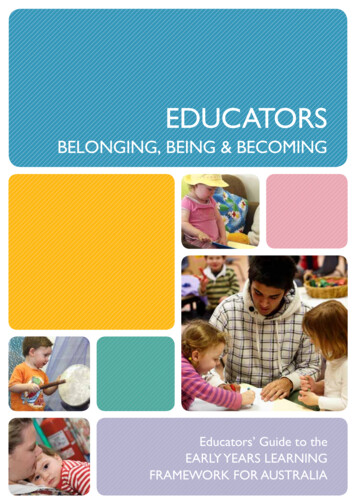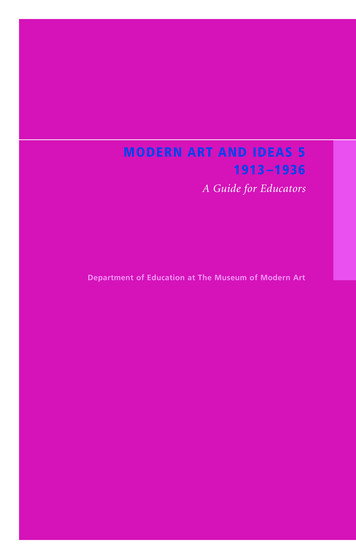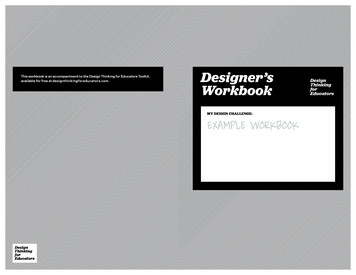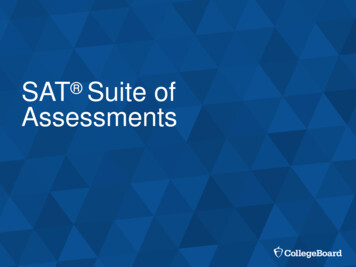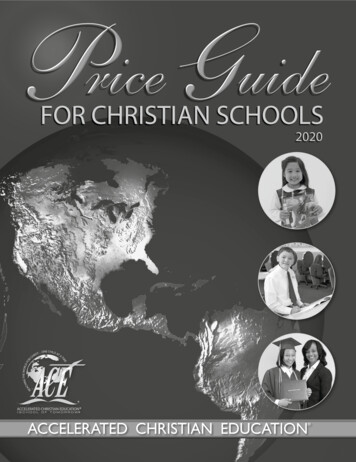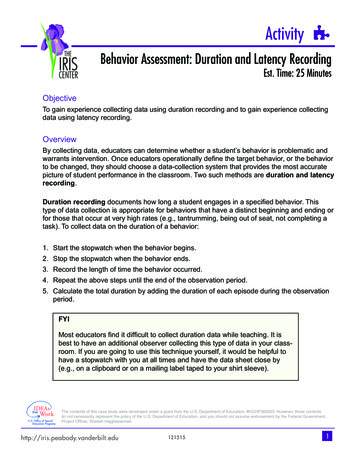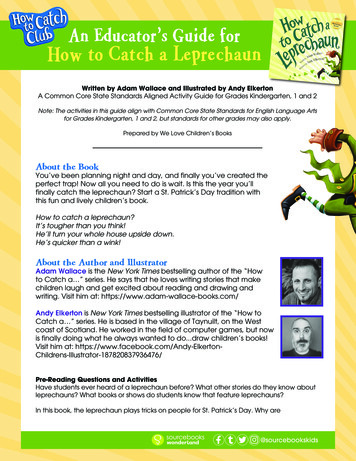
Transcription
An EducatorÕs Guide forHow to Catch a LeprechaunWritten by Adam Wallace and Illustrated by Andy ElkertonA Common Core State Standards Aligned Activity Guide for Grades Kindergarten, 1 and 2Note: The activities in this guide align with Common Core State Standards for English Language Artsfor Grades Kindergarten, 1 and 2, but standards for other grades may also apply.Prepared by We Love Children’s BooksAbout the BookYou’ve been planning night and day, and finally you’ve created theperfect trap! Now all you need to do is wait. Is this the year you’llfinally catch the leprechaun? Start a St. Patrick’s Day tradition withthis fun and lively children’s book.How to catch a leprechaun?It’s tougher than you think!He’ll turn your whole house upside down.He’s quicker than a wink!About the Author and IllustratorAdam Wallace is the New York Times bestselling author of the “Howto Catch a ” series. He says that he loves writing stories that makechildren laugh and get excited about reading and drawing andwriting. Visit him at: https://www.adam-wallace-books.com/Andy Elkerton is New York Times bestselling illustrator of the “How toCatch a ” series. He is based in the village of Taynuilt, on the Westcoast of Scotland. He worked in the field of computer games, but nowis finally doing what he always wanted to do.draw children’s books!Visit him at: lustrator-187820837936476/Pre-Reading Questions and ActivitiesHave students ever heard of a leprechaun before? What other stories do they know aboutleprechauns? What books or shows do students know that feature leprechauns?In this book, the leprechaun plays tricks on people for St. Patrick’s Day. Why are@sourcebookskids
An EducatorÕs Guide forHow to Catch a Leprechaunleprechauns associated with St. Patrick’s Day? Do students and their families have any St.Patrick’s Day traditions? Do leprechauns visit on St. Patrick’s Day? Have students ever set atrap for a leprechaun?VocabularyWhile you read the story aloud to the class, have students identify unfamiliar words andcreate a vocabulary list to go along with the book. Define the words as a class using anarray of strategies to determine meaning, including context, accompanying illustrations inthe story and the dictionary if needed. Provide real-life connections to these new words bydiscussing other situations where they could be used. Have students practice using thesenew words in a sentence. Can students think of other words that could be used that havesimilar meanings?RL K.4L K.4, K.5, 1.4, 1.5, 2.4, 2.5Post-Reading Questions and ActivitiesIt’s a trap!Break students into small groups and assign each group one of the traps from the book forcloser study. In this book, each child works alone to set a trap for the leprechaun. How doesthe leprechaun elude their traps? Have each group share their findings with the class. Whattrap makes the most sense to students?RL K.1, K.3, K.7, 1.1, 1.3, 1.7, 2.1, 2.7SL K.1, K.4, K.5, 1.1, 1.4, 1.5, 2.1, 2.4, 2.5The Last HouseThe final house has many different traps—and readers can see them through the windowsbefore the leprechaun goes inside. After the leprechaun escapes, the traps are left in ruins.Break the class into groups and assign each group one trap. Have them figure out howthey think it worked and locate the ruined remains of it in the illustration of the leprechaun’sescape. They should also theorize how the leprechaun defeated the trap. Have eachgroup present their ideas to the class.SL K1, K.4, K.5, 1.1, 1.4, 1.5, 2.1, 2.4, 2.5Looks Like It SoundsHave students noticed that certain words on each page of this story are written in adifferent style and color? Why do students think these specific words were chosen to behighlighted? How does the way they appear reflect their meaning or help the illustrationon that page to tell the story? Ask for volunteers to read a page aloud and pronounce theword in a way that reflects its meaning and fancy appearance.RL K.1, K.7, 1.1, 1.7, 2.1, 2.7SL K.1, K.2, 1.1, 1.2, 2.1, 2.2@sourcebookskids
An EducatorÕs Guide forHow to Catch a LeprechaunWhy?What does the leprechaun have that makes children want to catch him? Could theremore than one reason they set traps? Come together as a class and discuss the sorts ofpranks the leprechaun pulls. How would students react if he did that in their houses? Howwould their parents react? Besides leaving a mess and playing pranks, what else doesthe leprechaun leave behind? Why might his leaving gold (chocolate?) coins make thechildren want to catch him?RL K.1, K.3, K.7, 1.1, 1.3, 1.7, 2.1, 2.3, 2.7SL K.1, K.2, 1.1, 1.2, 2.1, 2.2How to Catch a LeprechaunHave students design and draw their own trap to catch the leprechaun. How does it work?How does the leprechaun elude it? Working with an adult, have students write rhyming textthat tells what is happening, like in the book. Have volunteers present their work to the class.Compile all these new pages and send them to the author and illustrator along with a letterto let them know how much the class enjoyed reading their book!W K.3, 1.3, 2.3SL K.4, K.5, 1.4, 1.5, 2.4, 2.5Compare and ContrastOne of the fun things about the How to Catch books is that each one is a little different,but they share common features across the series. Compare How to Catch a Leprechaunwith How to Catch an Elf. How are these stories similar? How are they different? Discuss themotivation of the children between the two books. Would students be more interested tocatch the Leprechaun or the elf? Why?RL K.1, K.3, K.7, K.9, 1.1, 1.3, 1.7, 1.9, 2.1, 2.3, 2.7SL K.1, K.2, 1.1, 1.2, 2.1, 2.2Rube Goldberg MachinesIn one house, there is a very complex trap with many crazy parts: a glove on a stick, acup of tea, boots on a pinwheel, a bowling ball, and more! Break students into smallgroups and have them study this page. Did the child build this trap alone, or did she havehelp? What in the book makes them think that? How was this trap supposed to work?Come together as a class and discuss their findings. Have students ever heard of a RubeGoldberg machine Look up information on Rube Goldberg and Rube Goldberg machineson the internet. Inspired by this research, have the whole class work together to design thecraziest, most complex trap they can! Did any other books have similarly complex devices?RL K.1, K.7, 1.1, 1.7, 2.1, 2.7W K.7, K.8, 1.7, 1.8, 2.7, 2.8SL K.1, K.5, 1.1, 1.5, 2.1, 2.5Visit the Common Core State Standards website to read about the individual standardslisted in this guide: ookskids
An EducatorÕs Guide forHow to Catch a LeprechaunFor ReferenceCommon Core State Standards UsedReading Standards for Literature KINDERGARTEN (RL)Key Ideas and DetailsK.1. With prompting and support, ask and answer questions about key details in a text.K.3. With prompting and support, identify characters, settings and major events in a story.Craft and StructureK.4. Ask and answer questions about unknown words in a text.K.6. With prompting and support, name the author and illustrator of a story and define therole of each in telling the storyIntegration of Knowledge and IdeasK.7. With prompting and support, describe the relationship between illustrations and thestory in which they appear (e.g., what moment in a story an illustration depicts).K.9. With prompting and support, compare and contrast the adventures and experiencesof characters in familiar storiesWriting Standards KINDERGARTEN (W)Text Types and PurposesK.3. Use a combination of drawing, dictating, and writing to narrate a single event orseveral loosely linked events, tell about the events in the order in which they occurred,and provide a reaction to what happened.Research to Build and Present KnowledgeK.7. Participate in shared research and writing projects (e.g., explore a number of books bya favorite author and express opinions about them).K.8. With guidance and support from adults, recall information from experiences or gatherinformation from provided sources to answer a question.Speaking and Listening Standards KINDERGARTEN (SL)Comprehension and CollaborationK.1. Participate in collaborative conversations with diverse partners about kindergartentopics and texts with peers and adults in small and larger groups.a. Follow agreed-upon rules for discussions (e.g., listening to others and taking turnsspeaking about the topics and texts under discussion).b. Continue a conversation through multiple exchangesK.2. Confirm understanding of a text read aloud or information presented orally orthrough other media by asking and answering questions about key details andrequesting clarification if something is not understood.@sourcebookskids
An EducatorÕs Guide forHow to Catch a LeprechaunPresentation of Knowledge and IdeasK.4. Describe familiar people, places, things and events and, with prompting and support,provide additional detail.K.5. Add drawings or other visual displays to descriptions as desired to provide additionaldetail.Language Standards KINDERGARTEN (L)Vocabulary Acquisition and UseK.4. Determine or clarify the meaning of unknown and multiple-meaning words and phrasesbased on kindergarten reading and content.a. Identify new meanings for familiar words and apply them accurately (e.g., knowingduck is a bird and learning the verb to duck).b. Use the most frequently occurring inflections and affixes (e.g., -ed, -s, re-, un-, pre-,-ful, -less) as a clue to the meaning of an unknown word.K.5. With guidance and support from adults, explore word relationships and nuances inword meanings.a. Sort common objects into categories (e.g., shapes, foods) to gain a sense of theconcepts the categories represent.b. Demonstrate understanding of frequently occurring verbs and adjectives by relatingthem to their opposites (antonyms).c. Identify real-life connections between words and their use (e.g., note places atschool that are colorful).d. Distinguish shades of meaning among verbs describing the same general action(e.g., walk, march, strut, prance) by acting out the meaningsReading Standards for Literature Grade 1 (RL)Key Ideas and Details1.1. Ask and answer questions about key details in a text.1.2. Retell stories, including key details, and demonstrate understanding of their centralmessage or lesson.1.3. Describe characters, settings, and major events in a story, using key details.Integration of Knowledge and Ideas1.7. Use illustrations and details in a story to describe its characters, setting, or events.1.9. Compare and contrast the adventures and experiences of characters in stories.Writing Standards Grade 1 (W)Text Types and Purposes1.3. Write narratives in which they recount two or more appropriately sequenced events,include some details regarding what happened, use temporal words to signal eventorder, and provide some sense of closure.@sourcebookskids
An EducatorÕs Guide forHow to Catch a LeprechaunResearch to Build and Present Knowledge1.7. Participate in shared research and writing projects (e.g., explore a number of “how-to”books on a given topic and use them to write a sequence of instructions).1.8. With guidance and support from adults, recall information from experiences or gatherinformation from provided sources to answer a question.Speaking and Listening Standards Grade 1 (SL)Comprehension and Collaboration1.1. Participate in collaborative conversations with diverse partners about grade 1 topicsand texts with peers and adults in small and larger groups.a. Follow agreed-upon rules for discussions (e.g., listening to others with care, speakingone at a time about the topics and texts under discussion).b. Build on others’ talk in conversations by responding to the comments of othersthrough multiple exchanges.c. Ask questions to clear up any confusion about the topics and texts under discussion.1.2. Ask and answer questions about key details in a text read aloud or informationpresented orally or through other media.1.3. Ask and answer questions about what a speaker says in order to gather additionalinformation or clarify something that is not understood.Presentation of Knowledge and Ideas1.4. Describe people, places, things, and events with relevant details, expressing ideas andfeelings clearly.1.5. Add drawings or other visual displays to descriptions when appropriate to clarify ideas,thoughts, and feelings.Language Standards Grade 1 (L)Vocabulary Acquisition and Use1.4. Determine or clarify the meaning of unknown and multiple-meaning words and phrasesbased on grade 1 reading and content, choosing flexibly from an array of strategies.a. Use sentence-level context as a clue to the meaning of a word or phrase.b. Use frequently occurring affixes as a clue to the meaning of a word.c. Identify frequently occurring root words (e.g., look) and their inflectional forms (e.g.,looks, looked, looking).1.5. With guidance and support from adults, demonstrate understanding of wordrelationships and nuances in word meanings.a. Sort words into categories (e.g., colors, clothing) to gain a sense of the concepts thecategories represent.b. Define words by category and by one or more key attributes (e.g., a duck is a birdthat swims; a tiger is a large cat with stripes).c. Identify real-life connections between words and their use (e.g., note places athome that are cozy).d. Distinguish shades of meaning among verbs differing in manner (e.g., look, peek,glance, stare, glare, scowl) and adjectives differing in intensity (e.g., large, gigantic)by defining or choosing them or by acting out the meanings.@sourcebookskids
An EducatorÕs Guide forHow to Catch a LeprechaunReading Standards for Literature Grade 2 (RL)Key Ideas and Details2.1. Ask and answer such questions as who, what, where, when, why, and how todemonstrate understanding of key details in a text.2.2. Recount stories, including fables and folktales from diverse cultures, and determine theircentral message, lesson, or moral.2.3. Describe how characters in a story respond to major events and challenges.Craft and Structure2.5. Describe the overall structure of a story, including describing how the beginningintroduces the story and the ending concludes the action.Integration of Knowledge and Ideas2.7. Use information gained from the illustrations and words in a print or digital text todemonstrate understanding of its characters, setting, or plot.Writing Standards Grade 2 (W)Text Types and Purposes2.3. Write narratives in which they recount a well-elaborated event or short sequence ofevents; include details to describe actions, thoughts, and feelings; use temporal wordsto signal event order; and provide a sense of closure.Research to Build and Present Knowledge2.7. Participate in shared research and writing projects (e.g., read a number of books on asingle topic to produce a report; record science observations).2.8. Recall information from experiences or gather information from provided sources toanswer a question.Speaking and Listening Standards Grade 2 (SL)Comprehension and Collaboration2.1. Participate in collaborative conversations with diverse partners about grade 2 topicsand texts with peers and adults in small and larger groups.a. Follow agreed-upon rules for discussions (e.g., gaining the floor in respectful ways,listening to others with care, speaking one at a time about the topics and textsunder discussion).b. Build on others’ talk in conversations by linking their comments to the remarks ofothers.c. Ask for clarification and further explanation as needed about the topics and textsunder discussion.2.2. Recount or describe key ideas or details from a text read aloud or informationpresented orally or through other media2.3. Ask and answer questions about what a speaker says in order to clarify comprehension,gather additional information or deepen understanding of a topic or issue.@sourcebookskids
An EducatorÕs Guide forHow to Catch a LeprechaunPresentation of Knowledge and Ideas2.4. Tell a story or recount an experience with appropriate facts and relevant, descriptivedetails, speaking audibly in coherent sentences.2.5. Create audio recordings of stories or poems; add drawings or other visual displays tostories or recounts of experiences when appropriate to clarify ideas, thoughts, andfeelings.Language Standards Grade 2 (L)Vocabulary Acquisition and Use2.4. Determine or clarify the meaning of unknown and multiple-meaning words and phrasesbased on grade 2 reading and content, choosing flexibly from an array of strategies.a. Use sentence-level context as a clue to the meaning of a word or phrase.b. Determine the meaning of the new word formed when a known prefix is added to aknown word (e.g., happy/unhappy, tell/retell).c. Use a known root word as a clue to the meaning of an unknown word with the sameroot (e.g., addition, additional).d. Use knowledge of the meaning of individual words to predict the meaning ofcompound words (e.g., birdhouse, lighthouse, housefly; bookshelf, notebook,bookmark).e. Use glossaries and beginning dictionaries, both print and digital, to determine orclarify the meaning of words and phrases.2.5. Demonstrate understanding of word relationships and nuances in word meanings.a. Identify real-life connections between words and their use (e.g., describe foods thatare spicy or juicy).b. Distinguish shades of meaning among closely related verbs (e.g., toss, throw, hurl)and closely related adjectives (e.g., thin, slender, skinny, scrawny).@sourcebookskids
Visit the Catch Club online athowtocatchclub.com for: A sign-up for the exclusive Catch Club emailnewsletter for downloadable activities andsneakpeeks at new How to Catch books Downloadable crafts and recipes Videos from Adam Wallace Games and contests And more!@sourcebookskids
One of the fun things about the How to Catch books is that each one is a little different, but they share common features across the series. Compare How to Catch a Leprechaun with How to Catch an Elf. How are these stories similar? How are they different? Disc



